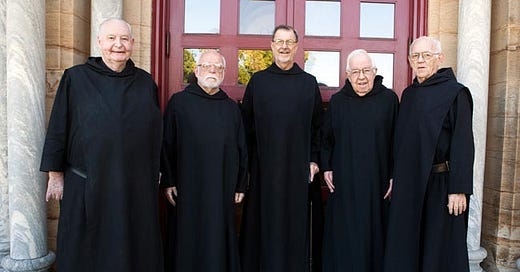The repertoire that par excellence represents the high point of a cappella music is Gregorian chant. Generation of singers, monks and laypeople, have sung these beautiful monophonic melodies, trying to attune their heart to the movement of the neumes in their melismatic arabesques.
Many years ago, I was in Malibu (California) for a conference on choral music. There I met Father Columba Kelly, an American Benedictine who passed away on June 9 2018, at the age of 87. I interviewed him then but the interview was published years later, so I take this opportunity to pay homage to Father Kelly, who was always very kind with me.
After his studies in Rome under the scholar Eugene Cardine in the fifties, Father Kelly continued his work in USA, in the abbey of Saint Meinrad.
Do you think a cappella singing has preeminence over accompanied singing?
“I think that in Catholic tradition, a cappella singing is the primary means of communicating especially at the Liturgy of the Hours and in the Eucharist. Over the years we’ve added instruments to the chant. But the primary mode is a cappella singing.”
For you, what is the added value of a cappella singing? Why is it better than accompanied singing?
“Because the vocal style of chant is quite different from any instrumental style and the nuances that come from the voice are different than those from an instrument, and most instruments either block out or contradict those vocal inflections. I remember the organ instructor who told his students “When you accompany chant make sure that the accompaniment is only heard when the singers stop singing.” That means that it’s almost not there. And I think this is one of the biggest problems. Contemporary Catholic composers are writing primarily for instruments. Their software presupposes instruments. So you start with the instrument to which you add words for a voice. My point is that with a cappella music you start with the voice and if necessary, you may add, for color and for effect or support in pitch, whatever instruments that would be appropriate.”
So am I to understand from your statement that you don’t like Gregorian chant accompanied by the organ?
“I think the ideal is that it should be unaccompanied. As Dom Cardine was want to say, it is pure vocal music with no instrumental accompaniment. Once you start adding an accompaniment then you’re also smearing over the delicate melodic nuances created by the added notes over a particular syllable. Once you put down a chord, you’re over-emphasizing certain pitches in the scale while the singers with the varied embellishments used in the chants, are just hinting at a certain harmonic color. It’s kind of like good French cooking versus McDonald’s hamburger.”
And we know that Pope Saint Pius X in the Motu Proprio Fra le Sollecitudini (1903) affirmed that Gregorian chant is a model for all church music, and it is a model for a cappella singing. What is it in Gregorian chant that makes it a model?
“I now wish, with the advantage of hindsight, that when the Pope had said this, that he had been able to use some of the chant scholars of his day, just as Pius XII did with his Encyclical on Sacred Scripture, when he got the scholars of his day involved. So my answer is, that the model is the fact that it starts with how one speaks the text well and how you pray it. Canon Augustine Gontier, who helped Solesmes at the beginning, put it well in his manual on how to sing chant. He said that it is “well spoken and phrased speech.” That it is sung prayer. And I think that is crucial. For you’re not doing a performance, you’re not doing an opera or theater. All the musical nuances come out in all the way the voice already expresses itself in speech. So it is the intensification of all the elements that are already present in good public proclamation of an important text. Cicero has remarked that in every speech there is “a cantus obscurior.” The basic elements of melody and rhythm are already present when we speak a text well. So I would say, that is the model for Gregorian chant. You start there, and then build up from there. Once you lose track of that, you should be aware that you’re no longer following the model.”
Keep reading with a 7-day free trial
Subscribe to Cantus to keep reading this post and get 7 days of free access to the full post archives.



